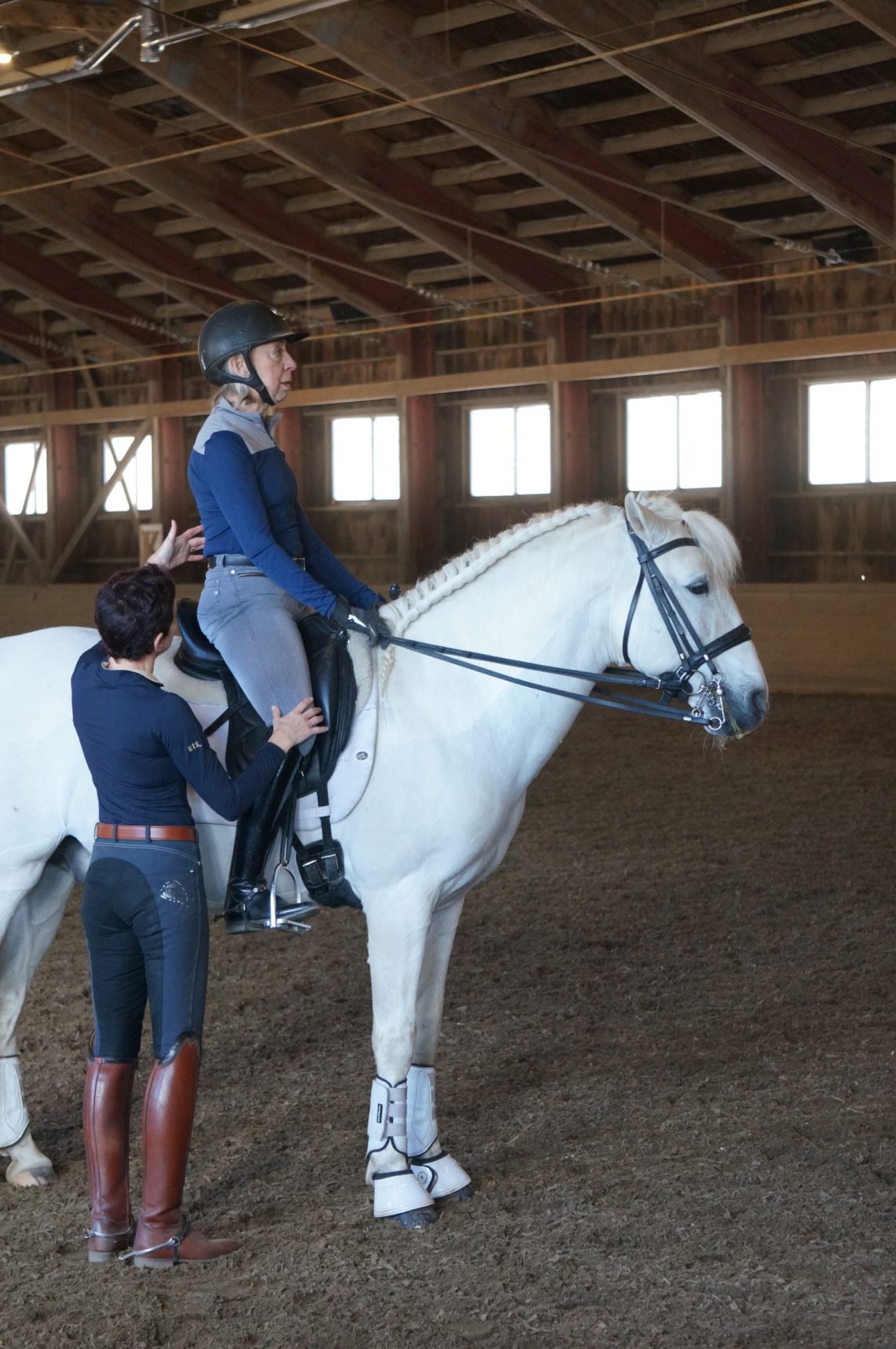
Finding harmony in training trot
Finding harmony in training trot
The trainer places his index finger on the rider’s loin to demonstrate where he must push through to find the correct pelvic movement in the training trot.
Dressage riders spend hundreds of hours, often adding up to years, to achieve amazing moments of complete harmony with their horses. Harmony comes when the horse is balanced, and his movements are light and powerful, smooth and elastic. The rider follows them without losing balance and self-confidence. In this article, I want to tell you how to achieve this.
The search for harmony is often a long-term process that includes many stages of learning. Sometimes it can be frustrating, it can be physically and emotionally difficult, but then there are moments when everything works out. After all, the reward is priceless. One particularly challenging exercise for the rider is the training trot, which we will focus on here.
Three aspects of rider harmony:
The rider should start from an upright, balanced position. The head should be balanced over his shoulders, hips and heels. To follow the horse in harmony, the rider first needs to learn the following three things:
1. Core muscles. These include a complex array of abdominal and back muscles that the rider uses to stabilize and position yourself in space. These muscles must be both elastic, relaxed and strong in order to move with the horse’s back.
2. Use of the pelvis. To follow the horse’s movement, the rider must allow the horse to move his pelvis while he cushions himself with his core. The pelvis should move back and forth, but not side to side.
3. Proprioception. Proper proprioception, or the sense of what the body is doing in space, has to do with the rider’s use of his core, pelvis, and entire body.
Try the following exercises:
For the whole body. One of the key ways to learn to join the horse’s movement through efficient use of the pelvis/core is to observe good riders. This includes a learning method based on the powerful tool of using mirror neurons, the use of brain cells that help people imitate the actions they observe. Watch the riders and see how they use their pelvis and core. Like Charlotte Dujardin or Debbie McDonald, for example, because they are amazingly relaxed and move smoothly. It seems that these riders do not move at all – their unity with the horse is so complete.
For mental proprioception. Whenever your center of gravity is not centered on the horse, when you are out of balance, you prevent him from moving forward. The rider may want to use a spur or whip when he thinks the horse is being lazy but doesn’t really realize that he is asking him to slow down with his body. He is surprised and grateful when he aligns with his body, loosens his leg, follows his core and allows the horse to move vigorously, following his energy, he allows him to freely increase momentum and bring his hindquarters down. Once you have regained your horse’s desire to move forward with your body, your controls will be able to act as effortlessly as possible, and this will help you find that elusive sense of oneness.
Following the horse’s energy requires a good idea of where our body is in relation to the surrounding space when we are in the saddle. One of the interesting things about teaching dressage to people is how often riders’ proprioception doesn’t match reality. The rider thinks he is sitting straight, when in fact he is leaning back, forward, falling to the right or left. The feeling of straightness is so strong that even if you completely trust your instructor, you cannot believe that you are not straight because your brain is telling you everything is fine. In such cases, mirrors on the walls of the arena can come to our aid. They can be a great tool to “restart” your proprioception, allowing you to start feeling the right balance on your horse.
Understanding how to sit at the training trot. You can learn how to properly move your pelvis in a training trot when the horse is standing. I place my index finger on the small of my back and ask the student to push it back with his back. I then place my other index finger in front of you next to your navel and ask you to move your belly towards that finger. You can repeat this movement several times. It will show you an exaggerated pelvic swing, which will then help you find the horse’s rhythm in all gaits, especially in the training trot.
Raise the horse into a slow trot, allow him to move forward on the snaffle and work his back, and take a posture. Once the trot is in tune and the horse has relaxed his back, sit down and try to follow his trot movements using your pelvis as you did during the halt. Try to speed up the pace of the pelvic movements to “catch up” with the horse or slightly “get ahead” of him. After you work out behind and ahead of the horse’s pace, you will finally find that ideal state where you follow the pace and feel completely connected to the movement of the horse’s back. You will immediately know the correct rhythm by how comfortable you become. You will now be able to ride a balanced, active connected training trot.
Jane Carol (source); translation Valeria Smirnova.





